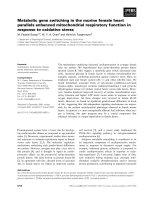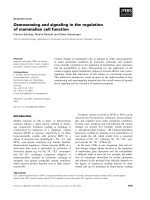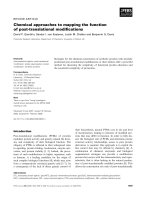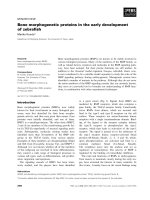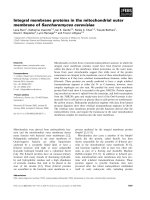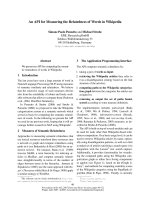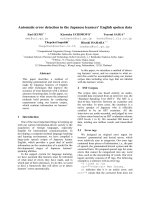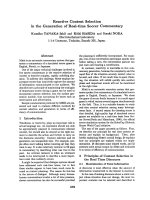Báo cáo khoa học: Hidden stereospecificity in the biosynthesis of divinyl ether fatty acids ppt
Bạn đang xem bản rút gọn của tài liệu. Xem và tải ngay bản đầy đủ của tài liệu tại đây (171.76 KB, 8 trang )
Hidden stereospecificity in the biosynthesis of divinyl
ether fatty acids
Mats Hamberg
Department of Medical Biochemistry and Biophysics, Karolinska Institutet, Sweden
Fatty acid hydroperoxides generated in plant tissues
by lipoxygenases or a-dioxygenases are subject to sec-
ondary modification by several enzymes [1]. One
branch of hydroperoxide metabolism involves forma-
tion of divinyl ether derivatives by carbon–carbon
bond cleavage catalyzed by specific divinyl ether synth-
ases. This type of transformation was first described in
1972 by Galliard and Phillips, who found that extracts
of potato tuber catalyzed the conversion of linoleic
acid 9(S)-hydroperoxide (9(S)-HPOD) into a divinyl
ether they named colneleic acid [2]. More recent work
has demonstrated that the divinyl ether synthase pro-
ducing colneleic acid and the related colnelenic acid is
induced in plant leaves during attack by fungal patho-
gens [3,4], and that divinyl ether fatty acids inhibit
mycelial growth and spore germination in certain fungi
Keywords
divinyl ether synthase; double bond
configuration; mechanism; stereospecifically
deuterated hydroperoxides; stereospecificity
of hydrogen abstraction
Correspondence
M. Hamberg, Department of Medical
Biochemistry and Biophysics, Division of
Physiological Chemistry II, Karolinska
Institutet, S-171 77 Stockholm, Sweden
Fax: +46 8736 0439
Tel: +46 852487640
E-mail:
(Received 13 October 2004, revised 29
November 2004, accepted 1 December
2004)
doi:10.1111/j.1742-4658.2004.04510.x
Incubations of [8(R)-
2
H]9(S)-hydroperoxy-10(E),12(Z)-octadecadienoic
acid, [14(R)-
2
H]13(S)-hydroperoxy-9(Z),11(E)-octadecadienoic acid and
[14(S)-
2
H]13(S)-hydroperoxy-9(Z),11(E)-octadecadienoic acid were per-
formed with preparations of plant tissues containing divinyl ether synth-
ases. In agreement with previous studies, generation of colneleic acid from
the 8(R)-deuterated 9(S)-hydroperoxide was accompanied by loss of most
of the deuterium label (retention, 8%), however, the opposite result (98%
retention) was observed in the generation of 8(Z)-colneleic acid from the
same hydroperoxide. Formation of etheroleic acid and 11(Z)-etheroleic acid
from the 14(R)-deuterated 13(S)-hydroperoxide was accompanied by loss
of most of the deuterium (retention, 7–8%), and, as expected, biosynthesis
of these divinyl ethers from the corresponding 14(S)-deuterated hydroper-
oxide was accompanied by retention of deuterium (retention, 94–98%).
Biosynthesis of x5(Z)-etheroleic acid from the 14(R)- and 14(S)-deuterated
13(S)-hydroperoxides showed the opposite results, i.e. 98% retention and
4% retention, respectively. The experiments demonstrated that biosynthesis
of divinyl ether fatty acids from linoleic acid 9- and 13-hydroperoxides
takes place by a mechanism that involves stereospecific abstraction of one
of the two hydrogen atoms a to the hydroperoxide carbon. Furthermore, a
consistent relationship between the absolute configuration of the hydrogen
atom eliminated (R or S) and the configuration of the introduced vinyl
ether double bond (E or Z) emerged from these results. Thus, irrespective
of which hydroperoxide regioisomer served as the substrate, divinyl ether
synthases abstracting the pro-R hydrogen generated divinyl ethers having
an E vinyl ether double bond, whereas enzymes abstracting the pro-S
hydrogen produced divinyl ethers having a Z vinyl ether double bond.
Abbreviations
colneleic acid, 9-[1¢(E),3¢(Z)-nonadienyloxy]-8(E)-nonenoic acid; colnelenic acid, 9-[1¢(E),3¢(Z),6¢(Z)-nonatrienyloxy]-8(E)-nonenoic acid; etheroleic
acid, 12-[1¢(E)-hexenyloxy]-9(Z),11(E)-dodecadienoic acid; etherolenic acid, 12-[1¢(E),3¢(Z)-hexadienyloxy]-9(Z),11(E)-dodecadienoic acid; 9(S)-
HPOD, 9(S)-hydroperoxy-10(E),12(Z)-octadecadienoic acid; 13(S)-HPOD, 13(S)-hydroperoxy-9(Z),11(E)-octadecadienoic acid.
736 FEBS Journal 272 (2005) 736–743 ª 2005 FEBS
[3,5]. Further research stimulated by these findings has
resulted in the cloning of genes encoding divinyl ether
synthases in tomato and potato and in the identifica-
tion of these enzymes as cytochrome P-450 proteins
[4,6].
The divinyl ether synthase-catalyzed formation of
colneleic acid from 9(S)-hydroperoxy-10(E),12(Z)-octa-
decadienoic acid in homogenate of potato tuber is
believed to take place via an enzyme-bound epoxide
carbocation [7–10]. Studies using stereospecifically deu-
terated substrate have shown that the double bond-
forming step in the biosynthesis of colneleic acid
involves stereoselective removal of the pro-R hydrogen
from C8 [8]. Several new divinyl ether synthases in
addition to the colneleic acid-forming enzyme have
been discovered during the last decade [11–14], and the
aim of this study was to determine the stereospecifici-
ties of these additional enzymes using hydroperoxides
stereospecifically deuterated at the appropriate carbon
atoms.
Results
Stereospecifically deuterated fatty acids and
hydroperoxides
Stereospecifically deuterated stearates were synthesized
starting with 8- or 14-hydroxystearates of high optical
purity. Deuterium was introduced by reduction of the
corresponding p-toluenesulfonates with lithium alumin-
ium deuteride, a reaction that takes place with clean
inversion of configuration [15] (Fig. 1). The deuterated
stearates were converted to the corresponding linole-
ates by exposure to growing cultures of the flagellate
Tetrahymena pyriformis. This biological desaturation
proceeds without significant degradation of the carbon
chain and without migration of the isotope [16], how-
ever, considerable dilution with unlabeled material
took place. Incubation of the deuterated linoleates
with soybean lipoxygenase or tomato lipoxygenase
resulted in deuterated 13(S)-HPOD and 9(S)-HPOD,
respectively, which had a deuterium content of 34–
49% (Table 1).
Stereospecificity of hydrogen eliminations from
C8 in the biosynthesis of colneleic acid isomers
It has been shown previously that biosynthesis of colne-
leic acid from 9(S)-HPOD catalyzed by divinyl ether
synthase in potato tuber is accompanied by stereoselec-
tive loss of the pro-R hydrogen from C8 [8]. This result
was confirmed here (Table 1). An isomer of colneleic
acid, i.e. 8(Z)-colneleic acid, was recently isolated from
leaves of the plant Clematis vitalba [14]. Interestingly,
biosynthesis of this compound from [8(R)-
2
H]9(S)-
HPOD took place with retention of the deuterium label,
i.e. a result opposite to that observed in the biosynthesis
of colneleic acid (Table 1, Fig. 2).
Stereospecificity of hydrogen eliminations from
C14 in the biosynthesis of etheroleic acid isomers
In the biosynthesis of etheroleic acid and its two iso-
mers, i.e. x5(Z)-etheroleic acid and 11(Z)-etheroleic
acid, one hydrogen is lost from C14. As seen in
Table 1, these conversions also took place with stereo-
specific hydrogen removals. In the case of etheroleic
acid (garlic) and 11(Z)-etheroleic acid (Ranunculus
Fig. 1. Reactions used to prepare stereospecifically deuterated fatty
acid hydroperoxides. The following reagents ⁄ treatments were used
(typical percentage yields are given within parenthesis): i, cinchoni-
dine (resolution; 10%); ii, acetyl chloride followed by treatment with
water ⁄ acetone (95%); iii, anodic coupling with methyl hydrogen
tridecanedioate (34%); iv, NaOH in methanol ⁄ water (95%); v,
CH
2
N
2
(99%); vi, p-toluenesulfonyl chloride ⁄ pyridine (86%); vii, lith-
ium aluminium deuteride (82%); viii, chromic acid (90%); ix, sodium
acetate (90%); x, Tetrahymena pyriformis (10%); xi, soybean lip-
oxygenase (95%). R
1
¼ (CH
2
)
7
-COOCH
3
,R
2
¼ (CH
2
)
7
-COOH.
M. Hamberg Stereospecificity of divinyl ether synthases
FEBS Journal 272 (2005) 736–743 ª 2005 FEBS 737
lingua) an essentially complete loss of isotope was
noted with the 14(R)-deuterated precursor, whereas
incubation of the 14(S)-deuterated precursor afforded
products that retained most of the deuterium label.
The opposite labeling pattern was observed in the bio-
synthesis of x5(Z)-etheroleic acid (Ranunculus acris),
i.e. stereospecific removal of the pro-S hydrogen and
retention of the pro-R hydrogen (Table 1, Fig. 2).
Discussion
Since the pioneering work by Schroepfer and Bloch on
the stereochemistry of the desaturation of stearate into
oleate [17], studies using stereospecifically deuterated
or tritiated precursors have generated important infor-
mation on enzyme-catalyzed reactions. In addition to
providing insights into reaction mechanisms, results
obtained with specifically labeled substrates have been
useful in molecular modeling studies of enzyme–sub-
strate complexes. An example from the oxylipin ⁄ eicos-
anoid field is the use of precursor acids labeled with
tritium in the 13(R) or 13(S) positions to elucidate the
stereochemistry and mechanism of the cyclooxygenase
reaction leading to prostaglandins [16], and the use of
this knowledge for establishing the productive confor-
mation of the arachidonic acid molecule bound to the
active site of the cyclooxygenase enzyme [18].
Divinyl ether synthases are cytochrome P-450
enzymes [4,6] and related to other (hydro)peroxide-
metabolizing P-450s such as allene oxide synthase [19],
hydroperoxide lyase [20,21], thromboxane synthase
[22] and prostacyclin synthase [22]. In the case of divi-
nyl ether biosynthesis, the initial step is believed to
consist of cleavage of the O-O bond of the hydroper-
oxide to provide an alkoxy radical, which undergoes
cyclization and one-electron oxidation into an epoxide
carbocation [23]. Enzyme-assisted removal of a pro-
ton a to the epoxide group and cleavage of the car-
bon-carbon single bond of the epoxide group provides
the final divinyl ether structure (Fig. 3). The nature of
the hydrogen-abstracting group in divinyl ether synth-
ases is unkown but may be either a basic amino acid
residue [7] or the strongly basic Fe
III
-OH group of the
P-450 heme [23].
This study confirms and extends previous work on
the divinyl ether synthase class of cytochrome P-450s
by showing that removal of one of the two hydro-
gens a to the hydroperoxide group invariably takes
place in a stereospecific way (Fig. 2). Furthermore,
inspection of the data given in Table 1 and Fig. 2
Table 1. Isotope composition of deuterated fatty acid hydroperox-
ides and divinyl ether fatty acids. Isotopic analysis was carried out
with selected ion monitoring mass spectrometry using the ions
m ⁄ z 225 and 226 (reduced[14–
2
H]13(S)-HPOD), m ⁄ z 311 and 312
(reduced[8-
2
H]9(S)-HPOD), and m ⁄ z 308 and 309 (divinyl ether fatty
acids).
Compound
Monodeuterated
molecules (%)
Retention of
deuterium (%)
[14(R)-
2
H]13(S)-HPOD 38.3 100
Etheroleic acid 2.8 7
x5(Z)-Etheroleic acid 37.4 98
11(Z)-Etheroleic acid 3.2 8
[14(S)-
2
H]13(S)-HPOD 33.9 100
Etheroleic acid 31.8 94
x5(Z)-Etheroleic acid 1.5 4
11(Z)-Etheroleic acid 33.3 98
[8(R)-
2
H]9(S)-HPOD 48.8 100
Colneleic acid 4.0 8
8(Z)-Colneleic acid 48.0 98
Fig. 2. Stereospecificities of five divinyl ether synthases. R
1
¼
(CH
2
)
6
-COOH, R
2
¼ (CH
2
)
7
-COOH. DES, divinyl ether synthase.
Fig. 3. Proposed sequence of reactions in the biosynthesis of divi-
nyl ether fatty acids. R
1
¼ C
5
H
11
and R
2
¼ (CH
2
)
6
-COOH (colneleic
acid series), or R
1
¼ (CH
2
)
7
-COOH and R
2
¼ C
4
H
9
(etheroleic acid
series). Adapted from Grechkin [23].
Stereospecificity of divinyl ether synthases M. Hamberg
738 FEBS Journal 272 (2005) 736–743 ª 2005 FEBS
reveals an interesting correlation, i.e. biosynthesis of
divinyl ethers having the E configuration of the newly
created vinyl ether double bond (colneleic acid, ethero-
leic acid and 11(Z )-etheroleic acid) takes place with
stereoselective loss of the pro-R hydrogen, whereas the
Z vinyl ethers (8(Z)-colneleic acid and x5(Z)-etheroleic
acid) are formed in a process which involves loss of
the pro-S hydrogen. These results can be intepreted in
terms of the conformations of the carbon–carbon sin-
gle bond a to the epoxide of the epoxide carbocation
intermediate, i.e. transoid and cisoid conformations are
needed to produce E and Z vinyl ether double bonds,
respectively (Fig. 4). As seen from this model, irres-
pective of the detailed structure of the surrounding act-
ive site, rotation of the carbon–carbon single bond to
produce the two conformations moves either the pro-R
or pro-S hydrogen in contact with the same region of
the active site. This may be taken to suggest that the
positioning of the hydrogen-abstracting group relative
to the bound substrate is highly conserved in all divi-
nyl ether synthases of higher plants. The stereochemi-
cal data also show that the hydrogen eliminated
consistently has a syn relationship to the vicinal oxy-
gen atom (Fig. 4). This stereochemistry is in agreement
with the notion [23] that the heme iron not only parti-
cipates in the hydroperoxidase reaction but also serves
as the hydrogen-abstracting group. Further interpret-
ation of the stereochemical data presented must await
access of the three-dimensional structures of the divi-
nyl ether synthase P-450s.
Experimental procedures
Plant materials
Specimens of Ranunculus acris L., Ranunculus lingua L and
Clematis vitalba L. were obtained as described previously
[12–14]. Leaves were either used directly or shock-frozen in
liquid nitrogen and stored at )80 °C until use. Tubers of
potato (var. Bintje) and bulbs of garlic were obtained from
a local market.
Stereospecifically deuterated hydroperoxides
[8(R)-
2
H]9(S)-Hydroperoxy-10(E),12(Z)-octadecadienoic
acid
9(S)-HPOD stereospecifically labeled with deuterium in the
8(R) position was prepared via [8(S)-
2
H]stearic acid (25 mg)
and [8(R)-
2
H]linoleic acid as described previously [8]. An
aliquot of the hydroperoxide was reduced by treatment
with sodium borohydride in methanol at 0 °C, and the
methyl ester ⁄ Me
3
Si derivative of the resulting hydroxide
was analyzed by GC ⁄ MS. The isotopic composition of the
sample was 48.8% monodeuterated and 51.2% undeute-
rated molecules as determined by mass spectrometric analysis
of the fragment [CH
3
OOC-(CH
2
)
7
-(CH ¼ CH)
2
-CH ¼
O
+
SiMe
3
](m ⁄ z 311 and 312 in the undeuterated and
deuterated derivatives, respectively). As expected from the
localization of the deuterium atom at C8, the fragment
[(CH ¼ CH)
2
-CH(OSiMe
3
)-(CH
2
)
4
-CH
3
]
+
(m ⁄ z 225) was
devoid of deuterium.
3(R,S)-Hydroxyheptanoic acid
Methyl 3-oxoheptanoate (39.5 g; 0.25 mmol; Fluka Chemie
GmbH, Buchs, Switzerland) was dissolved in methanol
(250 mL) and sodium borohydride (4 g) was added at 0 °C
over a period of 3 h under magnetic stirring. Subsequently,
a solution of sodium hydroxide (12 g) in water (100 mL)
was added and the mixture was stirred for 15 h at 23 °C.
Extraction with diethyl ether provided 3(R,S)-hydroxyhept-
anoic acid (36.1 g; 99%) as a colorless viscous oil which
slowly solidified at room temperature. The purity as
checked by GC ⁄ MS analysis of the methyl ester ⁄ Me
3
Si
derivative was > 95%.
3(R)-Hydroxyheptanoic acid
3(R,S)-Hydroxyheptanoic acid (14.6 g, 0.1 mmol) and
cinchonidine (29.4 g, 0.1 mmol) in carbon tetrachloride
(1 L) was heated on a boiling water bath for 3 min and
then allowed to cool to room temperature. The crystalline
Fig. 4. Conformations and hydrogen abstractions in the final step
of divinyl ether fatty acid biosynthesis. (A) Divinyl ether synthases
from potato, garlic or Ranunculus lingua introducing an ‘E’ vinyl
ether double bond, (B) divinyl ether synthases from Ranunculus
acris or Clematis vitalba introducing a ‘Z ’ vinyl ether double bond.
R
1
¼ (CH
2
)
6
-COOH and R
2
¼ C
5
H
11
(colneleic acid series) or R
1
¼
C
4
H
9
and R
2
¼ (CH
2
)
7
-COOH (etheroleic acid series). ‘B’ attached
to the enzyme surfaces, base.
M. Hamberg Stereospecificity of divinyl ether synthases
FEBS Journal 272 (2005) 736–743 ª 2005 FEBS 739
mass that separated was collected on a Bu
¨
chner funnel and
redissolved in CCl
4
(700 mL). The solution was left over-
night at 23 °C and the crystals formed ( 20 g) were again
subjected to crystallization from CCl
4
. After six such crys-
tallizations, rosette-formed crystals (2.5 g) of the cinchoni-
dine salt of 3(R)-hydroxyheptanoic acid were obtained.
Regeneration of the acid by acidification and extraction
with diethyl ether provided 3(R)-hydroxyheptanoic acid
(0.73 g; yield, 10% of the theoretical) having [a]
D
23
¼
)23.3° (c 2.5, chloroform); earlier published for 3(R)-
hydroxyhexanoic acid, [a]
D
¼ )28° [24] and for 3(R)-
hydroxyoctanoic acid, [a]
D
¼ )21° [25]. An aliquot was
esterified with diazomethane and converted to its 2(S)-
phenylpropionyl derivative [26]. Analysis by GLC showed
an enantiomeric composition of > 98% 3(R)- and < 2%
3(S)-hydroxyheptanoic acid.
Methyl 14(R)-hydroxystearate
3(R)-Hydroxyheptanoic acid (438 mg, 3 mmol) was refluxed
for 15 min with acetyl chloride (20 mL). The residue
obtained following evaporation of the reagent was dissolved
in acetone (20 mL), and water (13.3 mL) was added under
magnetic stirring. After 5 h at 23 °C, the solution was
extracted providing essentially pure 3(R)-acetoxyheptanoic
acid. This material was dissolved in methanol (100 mL)
containing methyl hydrogen tridecane-1,13-dioate (5.16 g,
20 mmol) and sodium methoxide (1.2 mmol). The solution
was transferred to an electrolysis cell and a current of
1.8 A was passed through for 2 h. The resulting product
was saponified, esterified by treatment with diazomethane,
and subjected to silicic acid open column chromatography.
Elution with diethyl ether ⁄ hexane (20 : 80, v ⁄ v) afforded
methyl 14(R)-hydroxyoctadecanoate (299 mg; yield, 32%).
Analysis by GC ⁄ MS showed a single peak (purity, > 96%)
on which a mass spectrum showing the following prominent
ions was recorded: m ⁄ z 296 (M
+
– 18; loss of H
2
O), 283
(M
+
– 31; loss of OCH
3
), 257 (M
+
– 57; loss of (CH
2
)
3
-
CH
3
), 225 (257–32; loss of CH
3
OH), 185, 143, 87, and 69.
Methyl 14(R)-p-toluenesulfonyloxystearate
Methyl 14(R)-hydroxystearate (157 mg, 0.5 mmol) was dis-
solved in dry pyridine (4 mL), cooled to )25 °C and treated
with p-toluenesulfonyl chloride (400 mg). After 12 h at
)25 °C and 48 h at +4 °C, water was added and the solu-
tion was extracted with diethyl ether. Purification by open
column silicic acid chromatography afforded methyl 14(R)-
p-toluenesulfonyloxystearate (200 mg, yield, 86%).
[14(S)-
2
H]Stearic acid
Methyl 14(R)-p-toluenesulfonyloxystearate (100 mg, 0.21
mmol) was refluxed with lithium aluminium deuteride
(300 mg; 98 atom percentage deuterium; purchased from
Sigma-Aldrich) in dry tetrahydrofuran (25 mL) for 18 h.
The resulting octadecanol was dissolved in 6 mL of acetone
and treated with 0.63 mL of Jones’ reagent at 23 °C for
30 min. The product was purified by open column silicic
acid chromatography to afford [14(S)-
2
H]stearic acid
(44 mg, yield, 74%). Analysis of an aliquot (methyl ester)
by GC ⁄ MS showed a single peak. The mass spectrum
showed the following prominent ions: m ⁄ z 299 (M
+
), 256
(M
+
– 43; loss of C
3
H
7
), 200 (M
+
– 99; loss of C
7
H
15
),
143, 87, and 74.
[14(S)-
2
H]Linoleic acid
A culture of Tetrahymena pyriformis strain phenoset A
(American Type Culture Collection #30327; Manassas, VA,
USA) was added to culture medium (400 mL) consisting of
glucose (0.5%, w ⁄ v), yeast extract (0.5%, w ⁄ v) and peptone
(0.5%, w ⁄ v) in 0.004 m potassium phosphate buffer pH 7.0
and containing the sodium salt of [14(S)-
2
H]stearic acid
(10 mg). The mixture was incubated under continuous sha-
king at 32 °C for 92 h [8]. The cell pellet collected by cen-
trifugation was suspended in 50% aqueous methanol
(100 mL) containing sodium hydroxide (7 g) and the mix-
ture was refluxed under an atmosphere of argon for
90 min. The isolated mixed fatty acids ( 9 mg) were
subjected to semipreparative RP-HPLC using a column of
Nucleosil C
18
100-7 (250 · 10 mm) purchased from
Macherey-Nagel (Du
¨
ren, Germany) and a solvent system
of acetonitrile ⁄ water ⁄ acetic acid (800 : 200 : 0.1, v ⁄ v ⁄ v) at
3mLÆmin
)1
. [14(S)-
2
H]Linoleic acid (2 mg) was collected at
68–72 mL effluent. The mass spectrum of the methyl ester
of this material showed molecular ions at m ⁄ z 294 and 295
corresponding to undeuterated and monodeuterated mole-
cules, respectively (ratio, 0.51), the undeuterated linoleate
being derived from the organism used to carry out the
desaturation.
[14(S)-
2
H]13(S)-Hydroperoxy-9(Z),11(E)-octadecadi-
enoic acid
[14(S)-
2
H]Linoleic acid (1.9 mg) was stirred for 10 min at
0 °C in 0.1 m sodium borate buffer pH 10.4 containing soy-
bean lipoxygenase (soybean lipoxygenase type IV purchased
from Sigma-Aldrich, 15 lL). Material isolated by extraction
with diethyl ether was purified by silicic acid open column
chromatography to provide 1.7 mg (yield, 80%) of the title
compound showing k
max
(EtOH) ¼ 233 nm. An aliquot
was reduced with NaBH
4
in methanol at 0 °C and the
resulting deuterated 13-hydroxy-9(Z),11(E )-octadecadieno-
ate was analyzed as the methyl ester ⁄ Me
3
Si derivative by
GC ⁄ MS using selected ion monitoring of the mass spectral
ions due to the fragment [(CH ¼ CH)
2
-CH(OSiMe
3
)-
(CH
2
)
4
-CH
3
]
+
(m ⁄ z 225 and 226 in undeuterated and
Stereospecificity of divinyl ether synthases M. Hamberg
740 FEBS Journal 272 (2005) 736–743 ª 2005 FEBS
deuterated hydroxides, respectively). The isotopic composi-
tion found after correction for the natural abundance of
the m ⁄ z 226 ion was 33.9% monodeuterated and 66.1% un-
deuterated molecules. As expected from the localization of
the deuterium label at C14, the fragment CH
3
OOC-(CH
2
)
7
-
(CH ¼ CH)
2
-CH ¼ O
+
SiMe
3
was undeuterated and gave
rise to an ion at m ⁄ z 311 with insignificant enrichment of
m ⁄ z 312.
[14(R)-
2
H]Stearic acid
Methyl 14(R)-p-toluenesulfonyloxystearate (100 mg, 0.21
mmol) was dissolved in acetic acid (7 mL) containing
sodium acetate (50 mg) and the mixture was kept at 60 °C
for 17 h. The product was saponified by refluxing with
10% NaOH in 80% aqueous methanol for 90 min and then
esterified by treatment with diazomethane and treated with
p-toluenesulfonyl chloride in pyridine as described above.
Reduction with lithium aluminium deuteride followed by
Jones oxidation and silicic acid open column chromato-
graphy afforded [14(R)-
2
H]stearic acid (22 mg; yield, 37%)
(Fig. 1).
[14(R)-
2
H]Linoleic acid
[14(R)-
2
H]Stearic acid (22 mg) was incubated with Tetra-
hymena pyriformis as described above and the free fatty
acids subjected to RP-HPLC to provide [14(R)-
2
H]linoleic
acid (4 mg; ratio of labeled ⁄ unlabeled molecules, 0.62).
[14(R)-
2
H]13(S)-Hydroperoxy-9(Z),11(E)-octadecadi-
enoic acid
[14(R)-
2
H]Linoleic acid (4 mg) was incubated with soybean
lipoxygenase as described above. Following purification by
silicic acid open column chromatography, [14(R)-
2
H]13(S)-
hydroperoxy-9(Z),11(E)-octadecadienoic acid (3 mg) was
obtained. The isotopic composition as determined by
GC ⁄ MS analysis of the methyl ester⁄ Me
3
Si derivative of
the reduced compound was 38.3% monodeuterated and
61.7% undeuterated molecules.
Enzyme preparations
The following divinyl ether synthase preparations were used
for study of the biosynthesis of the divinyl ethers indicated.
Colneleic acid
Tubers of potato were sliced and homogenized at 0 °Cin
0.1 m borate buffer pH 9.0 (2 : 1, v ⁄ w) using an Ultra-Tur-
rax. The homogenate was filtered through gauze and centri-
fuged at 9300 g for 15 min. Further centrifugation at
105 000 g provided a particulate fraction which was resus-
pended in borate buffer (half the volume compared with
the corresponding 105 000 g supernatant) [8].
Etheroleic acid
Bulbs of garlic were sliced and homogenized at 0 °Cin
0.1 m potassium phosphate buffer pH 8.0 (2 : 1, v ⁄ w). The
homogenate was filtered through gauze and successively
centrifuged at 1100 g for 15 min and 105 000 g to provide
a particulate fraction which was resuspended in phosphate
buffer (half the volume compared with the corresponding
105 000 g supernatant) [11].
x5(Z)-Etheroleic acid
Leaves of Ranunculus acris were minced and homogenized
at 0 °C in 0.1 m potassium phosphate buffer pH 6.7 (5 : 1,
v ⁄ w; buffer supplemented with 235 lm of salicylhydroxamic
acid as an lipoxygenase inhibitor). The filtered homogenate
was centrifuged at 1100 g for 15 min, and further centrifu-
gation of the supernatant at 105 000 g provided a particu-
late fraction that was resuspended in phosphate buffer (half
the volume compared with the corresponding supernatant)
[12].
11(Z)-Etheroleic acid
Leaves of Ranunculus lingua were treated in the same way
as described for Ranunculus acris [13].
8(Z)-Colneleic acid
Leaves of Clematis vitalba were homogenized at 0 °Cin
potassium phosphate buffer pH 6.7 (5 : 1, v ⁄ w) and the
homogenate was filtered through gauze [14].
Incubations and isolation of products
Suspensions of the particulate fractions of homogenates of
garlic, R. acris or R. lingua (2–20 mL) were stirred at 23 °C
for 20 min with 300 lm [14(R)-
2
H]- or [14(S)-
2
H]13(S)-
HPOD. In the same way, filtered homogenates of C. vitalba
(45 mL) or suspensions of the 105 000 g fraction of potato
tuber homogenate were stirred with 300 lm [8(R)-
2
H]
9(S)-HPOD. Material obtained after extraction with diethyl
ether was subjected to solid-phase extraction using an amino-
propyl column (0.5 g; Supelco, Bellefonte, PA, USA) [12].
Material eluted with diethyl ether ⁄ acetic acid (98 : 2, v ⁄ v)
was esterified by treatment with diazomethane and subjected
to RP-HPLC using a column of Nucleosil C
18
100–7
(250 · 10 mm) and a solvent system of acetonitrile ⁄ water
(80 : 20, v ⁄ v) at a flow rate of 4 mLÆmin
)1
. The effluent was
led to a Bischoff model DAD-100 diode-array detector (Bis-
choff Chromatography, Leonberg, Germany), and divinyl
M. Hamberg Stereospecificity of divinyl ether synthases
FEBS Journal 272 (2005) 736–743 ª 2005 FEBS 741
ethers localized by their strong absorption at 250–253 nm
were collected, esterified, and analyzed for deuterium content
by GC ⁄ MS. Blank incubations were performed in which the
divinyl ether synthase preparations were incubated in the
absence of hydroperoxide and subsequently carried through
the whole sequence. In the case of the enzyme preparation
obtained from garlic bulbs, significant amounts of endo-
genous etheroleic acid were detected, i.e. 3–4% of the levels
achieved in incubations carried out in the presence of added
13(S)-HPOD. The isotopic compositions of etheroleic acid
biosynthesized from deuterated precursors using this enzyme
preparation were corrected for the dilution caused by this
endogenous material. By contrast, no significant occurrence
of endogenous divinyl ethers was detected in the other four
preparations.
GC
/
MS
GC ⁄ MS was carried out with a Hewlett-Packard model
5970B mass-selective detector connected to a Hewlett-Pack-
ard model 5890 gas chromatograph equipped with a capil-
lary column of 5% phenylmethylsiloxane (12 m, 0.33 lm
film thickness). Helium was used as the carrier gas, and the
column temperature was raised at 10 °CÆmin
)1
from 120 to
260 °C. Isotopic composition of analytes were determined
using the selected ion monitoring mode and the following
mass spectral ions: m ⁄ z 225 and 226 (undeuterated and
monodeuterated [14-
2
H]13(S)-HPOD; reduced, methyl este-
rified and trimethylsilylated), m ⁄ z 311 and 312 ([8-
2
H]9(S)-
HPOD; reduced, methyl esterified and trimethylsilylated),
and m ⁄ z 308 and 309 (methyl esters of divinyl ether fatty
acids).
Acknowledgements
Mrs Gunvor Hamberg is thanked for expert technical
assistance and for collection and identification of the
plant materials used. This work was supported by a
generous grant given by the late Professor Sune Bergs-
tro
¨
m, Stockholm, and by grants from the Swedish
Research. Council for Environment, Agricultural
Sciences and Spatial Planning (project no. 2001-2553)
and the European Union (project No. QLK5-CT-2001-
02445).
References
1 Feussner I & Wasternack C (2002) The lipoxygenase
pathway. Annu Rev Plant Biol 53, 275–297.
2 Galliard T & Phillips DR (1972) The enzymic conver-
sion of linoleic acid into 9-(nona-1¢,3¢-dienoxy)non-
8-enoic acid, a novel unsaturated ether derivative
isolated from homogenates of Solanum tuberosum
tubers. Biochem J 129, 743–753.
3 Weber H, Che
´
telat A, Caldelari D & Farmer EE (1999)
Divinyl ether fatty acid synthesis in late blight-diseased
potato leaves. Plant Cell 11, 485–493.
4 Stumpe M, Kandzia R, Go
¨
bel C, Rosahl S & Feussner
I (2001) A pathogen-inducible divinyl ether synthase
(CYP74D) from elicitor-treated potato suspension cells.
FEBS Lett 507, 371–376.
5 Grane
´
r G, Hamberg M & Meijer J (2003) Screening of
oxylipins for control of oilseed rape (Brassica napus)
fungal pathogens. Phytochemistry 63 , 89–95.
6 Itoh A & Howe GA (2001) Molecular cloning of a divi-
nyl ether synthase. Identification as a CYP74 cyto-
chrome P-450. J Biol Chem 276, 3620–3627.
7 Crombie L, Morgan DO & Smith EH (1987) The enzy-
mic formation of colneleic acid, a divinyl ether fatty
acid: experiments with [(9 S )-
18
O
2
]hydroperoxyoctadeca-
(10E),(12Z)-dienoic acid. J Chem Soc Chem Commun
502–503.
8 Fahlstadius P & Hamberg M (1990) Stereospecific
removal of the pro-R hydrogen at C-8 of 9(S)-hydroper-
oxyoctadecadienoic acid in the biosynthesis of colneleic
acid. J Chem Soc Perkin Trans 1, 2027–2030.
9 Corey EJ, Nagata R & Wright SW (1987) Biomimetic
total synthesis of colneleic acid and its function as a
lipoxygenase inhibitor. Tetrahedron Lett 28, 4917–
4920.
10 Gerwick WH (1996) Epoxy allylic carbocations as con-
ceptual intermediates in the biogenesis of diverse marine
oxylipins. Lipids 31, 1215–1231.
11 Grechkin AN, Fazliev FN & Mukhtarova LS (1995)
The lipoxygenase pathway in garlic (Allium sativum L.)
bulbs: detection of the novel divinyl ether oxylipins.
FEBS Lett 371, 159–162.
12 Hamberg M (1998) A pathway for biosynthesis of divi-
nyl ether fatty acids in green leaves. Lipids 33, 1061–
1071.
13 Hamberg M (2002) Biosynthesis of new divinyl ether
oxylipins in Ranunculus plants. Lipids 37, 427–433.
14 Hamberg M (2004) Isolation and structures of two divi-
nyl ether fatty acids from Clematis vitalba. Lipids 39,
565–569.
15 Helmkamp GK & Rickborn BF (1957) Stereochemistry
of some lithium aluminium deuteride reductions. J Org
Chem 22, 479–482.
16 Hamberg M & Samuelsson B (1967) On the mechanism
of the biosynthesis of prostaglandins E
1
and F
1a
. J Biol
Chem 242, 5336–5343.
17 Schroepfer GJ & Bloch K (1965) The stereospecific con-
version of stearic acid to oleic acid. J Biol Chem 240,
54–63.
18 Malkowski MG, Ginell SL, Smith WL & Garavito RM
(2000) The productive conformation of arachidonic acid
bound to prostaglandin synthase. Science 289, 1933–
1937.
Stereospecificity of divinyl ether synthases M. Hamberg
742 FEBS Journal 272 (2005) 736–743 ª 2005 FEBS
19 Song W-C & Brash AR (1991) Purification of an allene
oxide synthase and identification of the enzyme as a
cytochrome P-450. Science 253, 781–784.
20 Matsui K, Shibutani M, Hase T & Kajiwara T (1996)
Bell pepper fruit fatty acid hydroperoxide lyase is a
cytochrome P-450 (CYP74B). FEBS Lett 394, 21–24.
21 Grechkin AN & Hamberg M (2004) The ‘heterolytic
hydroperoxide lyase’ is an isomerase producing a short-
lived hemiacetal. Biochim Biophys Acta 1636, 47–58.
22 Hecker M & Ullrich V (1989) On the mechanism of
prostacyclin and thromboxane A
2
biosynthesis. J Biol
Chem 264, 141–150.
23 Grechkin AN (2002) Hydroperoxide lyase and divinyl
ether synthase. Prostaglandins Other Lipid Med 68–69,
457–470.
24 Serck-Hanssen K (1956) Optically active higher aliphatic
hydroxy-compounds. Arkiv Kemi 10, 135–149.
25 Lemieux RU & Giguere J (1951) Biochemistry of ustal-
gines. Can J Chem 29, 678–690.
26 Hammarstro
¨
m S & Hamberg M (1973) Steric analysis
of 3-, x4-, x3- and x2-hydroxy acids and various alkan-
ols by gas–liquid chromatography. Anal Biochem 52,
169–179.
M. Hamberg Stereospecificity of divinyl ether synthases
FEBS Journal 272 (2005) 736–743 ª 2005 FEBS 743

